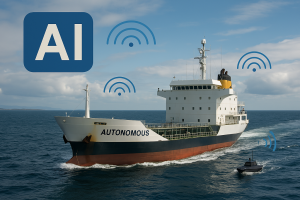Explore how AI in autonomous vessels is transforming shipping. Learn how Rolls-Royce and Maersk lead unmanned ship innovation, whether AI will replace captains, and how machine learning prevents collisions at sea.

Can a ship navigate the oceans without a crew?
In today’s world of automation and smart technology, AI in autonomous vessels is no longer a futuristic dream—it’s happening now. From Rolls-Royce’s unmanned ships to Maersk’s smart container vessels, artificial intelligence is redefining what it means to sail.
This article explores the evolution of autonomous shipping, answering key questions like:
-
Will AI replace ship captains?
-
How are leading companies using AI in smart vessels?
-
Can AI prevent collisions at sea?
Whether you’re a maritime student, cadet, officer, educator, or industry professional, understanding this transformation is essential for staying ahead in modern maritime operations.
What Is AI in Autonomous Vessels?
AI in autonomous vessels refers to the use of machine learning, computer vision, sensors, and decision-making algorithms to allow ships to operate with minimal or no human intervention.
Levels of Autonomy in Ships (As Defined by IMO and DNV):
-
Manual Navigation – Fully crewed, no automation
-
Decision Support – Crew assisted by AI-based systems (e.g., autopilot, radar analysis)
-
Remote Control – Operated from shore-based control centers
-
Fully Autonomous – AI makes real-time decisions without human input
⚓ Will AI Replace Ship Captains? The Future of Crewless Ships
The Short Answer: Not Completely—Yet.
AI systems are improving rapidly, but full autonomy still raises technical, legal, ethical, and regulatory questions.
What AI Can Do:
-
Analyze weather, traffic, and obstacles in real time
-
Make course adjustments and route optimization
-
Execute maneuvers like docking and collision avoidance
What AI Can’t Yet Fully Replace:
-
Human intuition during unpredictable emergencies
-
Leadership and crew management
-
Dynamic communication with port authorities and cargo stakeholders
🗨️ Quote: “AI is a co-pilot, not a captain—at least for now.” — Captain Robert J. Anderson, Maritime AI Advisor
🛳️ Case Study: How Rolls-Royce and Maersk Use AI in Smart Shipping
🚢 Rolls-Royce: Leading the Way in Crewless Innovation
-
Developed the “Autonomous Ship Intelligence Platform” (ASAIP)
-
Working on autonomous ferries in Finland with Finferries
-
AI handles real-time sensor fusion, voyage planning, and object detection
📦 Maersk: Enhancing Container Shipping with AI
-
Uses AI to optimize voyage planning and reduce fuel consumption
-
AI-based port call coordination reduces idle time and improves ETAs
-
Smart containers track location, temperature, and tampering using AI + IoT
📊 Stat: Rolls-Royce predicts fully autonomous commercial shipping could be viable by 2035, starting with short-sea and inland routes.
🧠 Can AI Prevent Collisions at Sea? Machine Learning in Navigation
Yes, and it’s already being implemented.
How AI Helps:
-
Computer Vision Systems: Detect nearby vessels, obstacles, and sea state
-
Radar + AIS Integration: Fuse inputs for smarter route decisions
-
Predictive Algorithms: Forecast vessel movements and issue warnings
-
Reinforcement Learning: AI “learns” from near-miss scenarios to improve over time
Real-World Example:
The SEA-KIT Uncrewed Surface Vessel (USV) used AI to safely complete a 22-day transatlantic crossing in 2022, autonomously adjusting its path in crowded traffic zones.
🚨 Bonus Insight: Collision-avoidance systems powered by AI are now used in dynamic positioning systems, especially in offshore support vessels.
🌐 Latest Trends in AI for Smart Shipping
| Trend | Details |
|---|---|
| Digital Twins | Real-time simulation of ship behavior using AI + sensor data |
| AI-Driven Route Optimization | Factors weather, fuel cost, emissions, and ETA to chart ideal paths |
| Shore-Based Command Centers | Human supervisors oversee multiple unmanned vessels simultaneously |
| Predictive Maintenance | AI monitors machinery health and schedules repairs before failure |
| Autonomous Tugboats | Used in harbors for safer and cost-effective mooring support |
📈 Forecast: The global market for autonomous ships is expected to reach $9.1 billion by 2030, according to Allied Market Research.
Conclusion: Navigating the Future with AI and Human Synergy
AI in autonomous vessels is not about replacing captains—it’s about enhancing maritime safety, sustainability, and efficiency. While crewless ships are becoming a reality, the maritime sector will continue to rely on skilled professionals who understand, manage, and co-pilot this next generation of vessels.
🌊 Call to Action: Whether you’re a cadet, ship officer, or maritime educator—now is the time to understand AI’s role in navigation, operations, and future shipping careers.
FAQs: People Also Ask
Will AI eliminate maritime jobs?
Not entirely. AI will change roles, not remove them. New skills will be required for remote supervision, cybersecurity, and AI system management.
How safe are autonomous ships?
Studies show that AI reduces human error (cause of over 75% of marine incidents), but human backup remains crucial in international waters and busy ports.
Which countries are testing autonomous vessels?
Countries like Norway, Finland, Japan, South Korea, and Singapore are pioneers in smart maritime innovation.
Can autonomous ships sail in rough seas?
Yes, but extreme weather still requires advanced predictive models and backup protocols. Human control is often retained in such scenarios.
References & Further Reading

